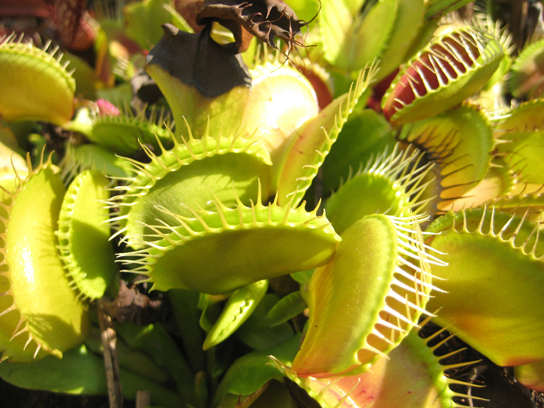Learning Outcomes
- Describe how heterotrophic plants obtain nutrients
Some plants cannot produce their own food and must obtain their nutrition from outside sources—these plants are heterotrophic. This may occur with plants that are parasitic or saprophytic. Some plants are mutualistic symbionts, epiphytes, or insectivorous.
Plant Parasites
A parasitic plant depends on its host for survival. Some parasitic plants have no leaves. An example of this is the dodder (Figure 1a), which has a weak, cylindrical stem that coils around the host and forms suckers. From these suckers, cells invade the host stem and grow to connect with the vascular bundles of the host. The parasitic plant obtains water and nutrients through these connections. The plant is a total parasite (a holoparasite) because it is completely dependent on its host. Other parasitic plants (hemiparasites) are fully photosynthetic and only use the host for water and minerals. There are about 4,100 species of parasitic plants.
Figure 1a. The dodder is a holoparasite that penetrates the host’s vascular tissue and diverts nutrients for its own growth. Note that the vines of the dodder, which has white flowers, are beige. The dodder has no chlorophyll and cannot produce its own food. (credit: “Lalithamba”/Flickr)
Saprophytes
A saprophyte is a plant that does not have chlorophyll and gets its food from dead matter, similar to bacteria and fungi (note that fungi are often called saprophytes, which is incorrect, because fungi are not plants). Plants like these use enzymes to convert organic food materials into simpler forms from which they can absorb nutrients (Figure 1b). Most saprophytes do not directly digest dead matter: instead, they parasitize fungi that digest dead matter, or are mycorrhizal, ultimately obtaining photosynthate from a fungus that derived photosynthate from its host. Saprophytic plants are uncommon; only a few species are described.
Figure 1b. Saprophytes, like this Dutchmen’s pipe (Monotropa hypopitys), obtain their food from dead matter and do not have chlorophyll. (credit: modification of work by Iwona Erskine-Kellie)
Symbionts
A symbiont is a plant in a symbiotic relationship, with special adaptations such as mycorrhizae or nodule formation. Fungi also form symbiotic associations with cyanobacteria and green algae (called lichens). Lichens can sometimes be seen as colorful growths on the surface of rocks and trees (Figure 2a). The algal partner (phycobiont) makes food autotrophically, some of which it shares with the fungus; the fungal partner (mycobiont) absorbs water and minerals from the environment, which are made available to the green alga. If one partner was separated from the other, they would both die.
Epiphytes
An epiphyte is a plant that grows on other plants, but is not dependent upon the other plant for nutrition (Figure 2b). Epiphytes have two types of roots: clinging aerial roots, which absorb nutrients from humus that accumulates in the crevices of trees; and aerial roots, which absorb moisture from the atmosphere.

Figure 2. (a) Lichens, which often have symbiotic relationships with other plants, can sometimes be found growing on trees. (b) These epiphyte plants grow in the main greenhouse of the Jardin des Plantes in Paris. (credit: a “benketaro”/Flickr)
insectivorous plants

Figure 3. A Venus flytrap has specialized leaves to trap insects. (credit: “Selena N. B. H.”/Flickr)
An insectivorous (carnivorous) plant has specialized leaves to attract and digest insects. The Venus flytrap is popularly known for its insectivorous mode of nutrition and has leaves that work as traps (Figure 3).
Although often described as heterotrophic, carnivorous plants like the Venus flytrap are actually autotrophic because they carry out photosynthesis and produce their own food using sunlight, water, and carbon dioxide—just like other green plants. Their insect-catching ability supplements their diet by providing essential minerals, particularly nitrogen and phosphorus, that are scarce in the nutrient-poor, acidic (low pH) soils where they grow. In other words, they rely on insects for minerals, not for energy or carbon.
The Venus flytrap’s minerals obtained from prey compensate for those lacking in the boggy soil of its native North Carolina coastal plains. Each leaf has three sensitive hairs in the center of each half. The edges of the leaf are lined with long spines, and nectar secreted by the plant attracts flies. When a fly touches the sensory hairs, the leaf quickly closes, trapping the prey. Digestive fluids and enzymes then break down the insect, allowing the leaf to absorb the released minerals.
Because this unique plant is highly sought after in the horticultural trade, the Venus flytrap is now threatened in its original habitat.
Try It
Candela Citations
- Biology 2e. Provided by: OpenStax. Located at: http://cnx.org/contents/185cbf87-c72e-48f5-b51e-f14f21b5eabd@10.8. License: CC BY: Attribution. License Terms: Access for free at https://openstax.org/books/biology-2e/pages/1-introduction
